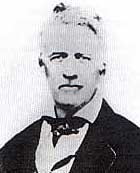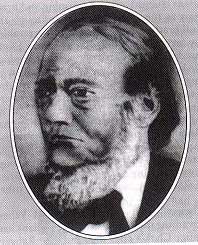Moore's Comanche Fight, 1835 |
|

Colonel John Henry Moore
Moore Leads Republic's First Ranger Attack Against Indians
Fort Tours chief scout, Steve "Cougar" Nichols,
summarizes the records of Robertson Colony.
The Robertson colonists employed a friendly Caddo chief
named Canoma to go among the savages in 1835 and endeavor to bring
them in for the purpose of making a treaty and recovering two children
of a Mr. Moss who were then prisoners in their hands. This same chief
had pursued some Indians who had murdered H. Reed near Tenoxtitlan
in 1832 and recovered Reed's horse and saddle and returned them to
his father.
Canoma left two of his children as hostages, undertook
the mission, and visited several tribes. When he came back he reported
that those he had seen were willing to make a treaty with the Brazos
people but that about half of them were bitterly opposed to forming
friendly relations with the settlers along the Colorado. In fact,
at that very moment, he said, a party of the irreconcilable Indians
was making a descent on Bastrop. The people at the Falls of the Brazos
sent a runner, Samuel McFall, to warn the people of Bastrop but by
the time he got there the Indians had already entered the settlement,
and on June 1, 1835 they had attacked a wagon on the road from San
Felipe to Bastrop on the waters of Cummins Creek and killed Amos Alexander
and his son and escaped with the goods from the wagon.
In the meantime, two immigrants named Warnick and Elam
had stopped at the Falls of the Brazos and while there they were both
taken sick and their horses, turned loose to graze, ran away across
the Brazos and Little River and on down to Brushy Creek. Mr. Marlin
employed two Caddo chiefs, Canoma and Dorcha (or Douchey) to retrieve
the horses if possible. When they started, Mr. Marlin presented each
with a new shirt.
The Indians trailed the horses to Brushy Creek where
a short time before this, Indians from other tribes had been committing
depredations on the settlers around Bastrop. Some of these settlers,
under Colonel Edward Burleson, had decided to follow the Indians that
had been troubling them. The trail led to Brushy Creek where they
found Canoma and Dorcha with the American horses in their possession.
The posse immediately thought these were the Indians
who had been troubling them and in their rage and excitement decided
to kill the two chiefs forthwith. The two Caddos told them that Marlin
had sent them after the horses and showed them the new shirts Marlin
had given them and begged the settlers to go with them to the Falls,
less than thirty miles distant, where their story could be verified
but this request was denied.
Moses Cummins wrote Empresario Robertson relating these
events. He recommended that Robertson write Burleson a letter and
have someone carry it to him immediately before these citizens, in
their rage, could do violence "to those innocent Indians."
The Burleson party had gone up to the country taking Canoma and Dorcha
with them and Cummins said that their trail could be easily found
somewhere between the heads of Cow Bayou and the Leon River. Burleson
had agreed not to harm the Indians without bringing them into the
settlement for a hearing but his men were enraged and crying for blood.
"Such men," Cummins wrote, "in such a state of mind,
are not apt to discriminate between guilt and innocence."
Cummins was right in his prediction. Colonel Burleson
was unable to control the mob psychology of his men. They tied Canoma
and his son to trees and shot them, leaving his wife to get home as
best she could. Stephen Townsend and John Rabb, two members of the
party opposed to the killing but unable to prevent it, left the company
rather than witness what they deemed to be murder.
Canoma's wife wasted no time getting back to the settlement
where she reported the facts exactly as they had happened. This so
incensed the remainder of Canoma's people, who were still at the Falls,
that Choctaw Tom, the principal man left amongst them, stated that
they could not blame the people at the Falls, but that all the Indians
would now make war on the settlers along the Colorado. With all the
band, he left for Indian country.
The young warriors notified the settlers near Mr. Marlin
that they were going to make war on the whites but promised that they
would never molest the whites in that locality. They kept this promise
for about twelve months. Then the name of Chief Dorcha turned up in
the attack on Fort Parker on May 19, 1836. Later, the Caddos, Ionis,
Anadarkos and Kichais united under Chief Jose Maria and their terrible
butchery and pillaging began. One of the first families murdered was
one of those whom the Caddos had promised not to molest, the George
Morgan family, whose home they attacked on January 1, 1839.
The following is from the book, The Men Who Wear the Star,
by Charles M. Robinson, III:
In July, 1835, a company of men under Capt. Robert M. Coleman attacked
a Tawakoni village in what is now Limestone County, east of Waco.
Though surprised, the Indians outnumbered the whites, forcing them
to retreat to Parker's Fort, seat of the Parker clan, some forty
miles east of Waco. Coleman sent for help and was reinforced by
three companies under Col. John H. Moore. The Indians retreated.
Moore's Rangers combed the countryside as far as the present site
of Dallas before returning home. These various skirmishes, insignificant
on their own, would have far-reaching repercussions, not only with
the local tribes but with the powerful Comanches of the Plains.

George Erath
In early August of 1835, Colonel Moore's Ranger's responded
to Coleman's bloody July encounter with the Tonkawas. The Colonel led
Ranger Captains Williamson, Barnett, Coe, Goheen and Coleman and their
companies northwest from Parker's Fort to even the score. Ranger George
Erath later wrote:
After waiting for the swollen Navasota to run down,
we marched on to the village. Texas Indians never allowed themselves
to be attacked by a hundred men together; they had evacuated the
village, and we had nothing to do but occupy it. We found sixty
acres in corn, which was just hard enough to be gritted, and by
making holes in the bottom of the tin cups we carried we fashioned
graters, and supplied ourselves with bread. There were also numbers
of pumpkins, watermelons, muskmelons, peas and other vegetables,
such as were then raised by Indians in their primitive agriculture.
Two days later the troops were on Post Oak Creek when
scouts reported Indians ahead. Erath comments that Moore "took
as much precaution as if we were about to fight such formidable foes
as Creeks, Cherokees, and Seminoles-foes the two had faced in their
younger days under Jackson." Battle lines were formed. Erath further
wrote:
I was riding a young horse which had been caught a colt from
the mustangs, that was fiery. When the order came to charge, it
darted forward ahead of all the rest, and I found myself alone
in the advance. Next came McFall, who was also on a wild horse,
too eager for the fray. The officers shouted to us to come back
into line, but our efforts to obey were in vain. Our steeds had
determined to give us a reputation for bravery which we did not
deserve.
The incident also earned Erath the nickname, "The
Flying Dutchman". The battalion trudged on northwest until the
end of August when the Rangers enlistments began to expire and many
chose to return to their families. Erath continues:
The main body of the Indians were never overtaken; but several
small scattering parties were met, with which there was some skirmishing.
The Texan forces kept daily diminishing, and in two months the
expedition closed.
Moore led the remaining volunteers to the forks of the Trinity, where
Dallas now stands, before turning back to the southeast, passing through
the future site of Fort Graham. The force returned to Moore's Fort
in Mina (present day Bastrop) and disbanded.
|